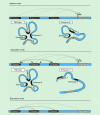Enhancer talk
- PMID: 29583027
- PMCID: PMC5925435
- DOI: 10.2217/epi-2017-0157
Enhancer talk
Abstract
Enhancers are short noncoding segments of DNA (100-1000 bp) that control the temporal and spatial activity of genes in an orientation-independent manner. They can be separated from their target genes by large distances and are thus known as distal regulatory elements. One consequence of the variability in the distance separating enhancers and their target promoters is that it is difficult to determine which elements are involved in the regulation of a particular gene. Moreover, enhancers can be found in clusters in which multiple regulatory elements control expression of the same target gene. However, little is known about how the individual elements contribute to gene expression. Here, we describe how chromatin conformation promotes and constraints enhancer activity. Further, we discuss enhancer clusters and what is known about the contribution of individual elements to the regulation of target genes. Finally, we examine the reliability of different methods used to identify enhancers.
Keywords: 3D conformation; CTCF; LCRs; TADs; chromatin contacts; cohesin; enhancers; stretch enhancers; super enhancers.
Conflict of interest statement
JA Skok is supported by NIH grant R35GM122515, 4P30CA016087-36 Cancer Center Support Grant NIH/NCI (Neel) and 2R01CA140729-06A1 NIH/NCI (Carroll). The authors have no other relevant affiliations or financial involvement with any organization or entity with a financial interest in or financial conflict with the subject matter or materials discussed in the manuscript apart from those disclosed.
No writing assistance was utilized in the production of this manuscript.
Figures




References
-
- Banerji J, Rusconi S, Schaffner W. Expression of a beta-globin gene is enhanced by remote SV40 DNA sequences. Cell. 1981;27(2 Pt 1):299–308. - PubMed
-
- Lettice LA, Heaney SJ, Purdie LA, et al. A long-range Shh enhancer regulates expression in the developing limb and fin and is associated with preaxial polydactyly. Hum. Mol. Genet. 2003;12(14):1725–1735. - PubMed
Publication types
MeSH terms
Substances
Grants and funding
LinkOut - more resources
Full Text Sources
Other Literature Sources
